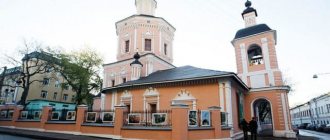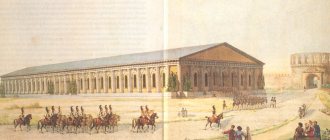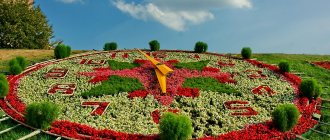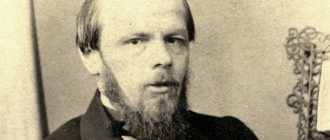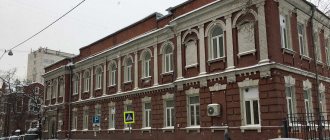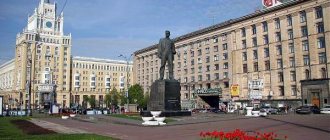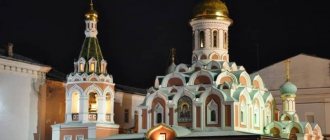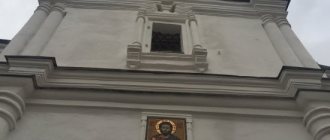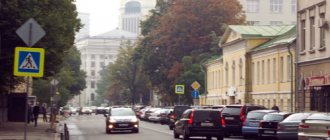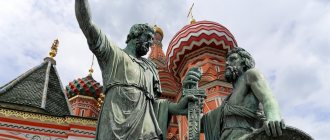Nikitsky Boulevard - origin of the name
Back in the 16th century, the Nikitsky convent was founded in this area of Moscow, which was rebuilt on the site of the destroyed Nikita Church, which was located near the Yamsky courtyard. The ideological inspirer was the grandfather of the Russian autocrat Mikhail Fedorovich - boyar Zakharin-Yuryev.
The gates of the White City, located not far from the walls of the monastery, were named Nikitsky.
By the end of the seventeenth century, the walls of the White City with its numerous gates were destroyed, and in their place, over time, the famous Boulevard Ring appeared.
The section of the boulevard ring, between the current squares of the Nikitsky and Arbat Gates, began to be called Nikitsky Boulevard - in honor of the convent and the former gates of the White City.
During the years of Soviet power, the monastery was abolished, and by 1933 it was completely destroyed. In its place, in 1935, an electrical substation was erected for the metro under construction (B. Kislovsky, 7).
From the former greatness of the Nikitsky Monastery, only cells built in the 17th-18th centuries remained (B. Kislovsky, 10).
Moscow
Let's take another walk around Moscow. This time my goal was Nikitsky Boulevard. But on the way from home I paid attention to other sights and buildings that interested me. So from Bolshoy Kozikhinsky Lane, Moscow Lanes. Around the Patriarchs we go out onto Bolshaya Bronnaya Street. It starts from Malaya Bronnaya Street, crosses Bogoslovsky and Sytinsky Lanes and ends at the intersection with Tverskaya Street. Its length is only about 750 meters. Bolshaya Bronnaya Street received its name back in the seventeenth century from the local Bronnaya Sloboda, organized by Tsar Ivan the Terrible back in the 1560s. Local gunsmiths were engaged in the production of “armor” - they forged armor and chain mail, as well as all kinds of edged weapons. Due to the reconstruction carried out in the 60-70s of the last century, its appearance changed and not for the better, many houses were demolished, and in their place appeared houses similar to each other, decorated with yellowish ceramic tiles. I drew attention to house No. 10 House of E. I. Polyakov (decoration - 1906, architect I. E. Bondarenko), currently the Military Industrial Bank.
Liked!
2
2
Author: Nina__Pastuhova
But the most famous building on this street is the Synagogue. A famous railway contractor, industrialist, banker and philanthropist, Lazar Solomonovich Polyakov, who headed the railway from 1869. for forty years the rule of the Jewish Moscow community, in 1872. received permission from the Moscow Governor-General to place in his house “a prayer institution with parishioners of up to 40 families.” In the early 1880s he acquired and annexed several neighboring plots to his vast estate on Tverskoy Boulevard. Having received permission from the Chief of Police of Moscow, L.S. Polyakov in 1883 submitted a petition to the Construction Department to adapt a residential building facing Bolshaya Bronnaya Street into a home synagogue.
Liked!
0
0
Author: Nina__Pastuhova
Photo from 1898. The building, designed by the famous architect M.N. Chichagov, received a beautiful facade in the Moorish style. The purpose of the building was indicated by the design of the main entrance, crowned with a six-pointed star. The territory of the synagogue was surrounded by a fence, and an underground passage was provided in the building to save worshipers in the event of possible pogroms. This was the first building in Moscow built as a synagogue. After the revolution, the building was given to trade unions, and then the Moscow House of Amateur Arts was located here. Only in 1991, by a decision of the Moscow Government signed by Yu.M. Luzhkov, the synagogue on Bolshaya Bronnaya was returned to the believers. In Soviet times, it was rebuilt, but after the reconstruction the façade was restored to its original appearance; they also made a huge stained-glass window through which the street façade is visible—the “scalloped” entrance arch, the “Moorish windows,” and the Assyro-Babylonian battlements above the cornice.
Liked!
1
1
Author: Nina__Pastuhova
Let's go further, on the corner of Bolshaya Bronnaya and Malaya there is a restaurant "Aist" with such an interesting sculpture.
Liked!
2
2
Author: Nina__Pastuhova
And we turn onto Malaya Bronnaya. It also received its name from the Bronnaya Sloboda, established here at the beginning of the 16th century. Here, not far from the Synagogue, is the Monument to Sholom Aleichem, the famous Jewish writer.
Liked!
1
1
Author: Nina__Pastuhova
And on the other side, diagonally, there is a building, the end of which reminded me of the work of Gaudi. Apparently his work made a great impression on someone.
Liked!
1
1
Author: Nina__Pastuhova
This is house No. 4, building 1 - the House of the “Society for Benefiting Needy Students of the Imperial Moscow University” (1909, architect K. K. Gippius), an identified object of cultural heritage, currently the Moscow Drama Theater on Malaya Bronnaya. And here is the main entrance to the theater. I was not able to visit it this time.
Liked!
0
0
Author: Nina__Pastuhova
photo from the Internet
We go further and the house on the corner of Malaya Bronnaya and Tverskoy Boulevard is number 2/7. Based on the surname of the owner, the house was popularly called “Romanovka”. In the second half of the 18th century, the owner of this plot was Colonel V.V. Grushetsky is a future senator and participant in the war with Turkey. In 1771, the plot passed to the Golitsyn family. At this time, according to the design of the architect M.F. Kazakov, the main house of the estate and two outbuildings were built. During the fire of 1812, the estate was damaged by fire and was restored. In 1882, architect V.P. Zagorsky connected the wings of the estate to each other and built on them. In 1893, another floor was added to this building, making it four stories. Romanovka housed cheap furnished rooms in which students of the Conservatory and the Moscow School of Painting, Sculpture and Architecture lived. One of the residents during his student years was the future famous opera singer L.V. Sobinov.
Liked!
0
0
Author: Nina__Pastuhova
At the end of the 1890s, a music salon opened in Romanovka. Rimsky-Korsakov, Konstantin Korovin and M.A. Vrubel and his wife, the famous singer Zabela-Vrubel, whom Rimsky-Korsakov considered an unsurpassed performer of his works, often visited here. Chaliapin himself sang here. Now this building houses the theater "On Malaya Bronnaya". Well, we turn right and walk along Tverskoy Boulevard to the Nikitsky Gate. In the park, on the site of the estate of the famous princely family of the Gagarins, there is a monument to K.A. Timiryazev (sculptor S.D. Merkurov, architect D.P. Osipov). The monument was erected on November 4, 1923.
Liked!
3
3
Author: Nina__Pastuhova
Timiryazev stands facing the square. The sculpture depicts the eminent scientist in the robes of a doctor of the University of Cambridge and the inscription “K.A. Timiryazev. A fighter and a thinker." Passing by the rotunda
Liked!
2
2
Author: Nina__Pastuhova
on Malaya Nikitskaya, opposite the church, I liked the house, it seemed like an ordinary Moscow Art Nouveau, but I was interested in the wide ornamental horizontal belt above the fifth floor windows, depicting climbing stems of plants with leaves and flowers.
Liked!
0
0
Author: Nina__Pastuhova
We return again to the intersection, to the Nikitsky Gate Square, they are located at the intersection of Bolshaya Nikitskaya Street and the Boulevard Ring. Their main attractions are described in Walking around Moscow, along Bolshaya Nikitskaya. Part two. It remains only to mention the theater “At the Nikitsky Gate”.
Liked!
0
0
Author: Nina__Pastuhova
The name “Nikitsky Gate” appeared at the end of the 16th century. The name of the square, as well as the adjacent boulevard and streets, comes from the Nikitsky Gate, which was one of the 11 carriageway gates of the White City. In turn, the Nikitsky Gate received its name from the Nikitsky Monastery, founded in 1582 by Nikita Zakharyin, the father of Patriarch Filaret and the grandfather of Tsar Mikhail Fedorovich. After the walls of the White City were demolished in the 1780s, a boulevard was to be built in their place according to the plan of 1775, but the implementation of the plan began only in the first half of the 19th century, since the land was already occupied by various buildings. Until the end of the 190s, the boulevard was closed on the side of Arbat Square by a three-story building. When the transport tunnel was laid, the house was demolished, and the boulevard was shortened due to the exit from the tunnel. The width of the boulevard is approximately 19 meters, with lawns and shady trees, some of which are one and a half centuries old.
Liked!
0
0
Author: Nina__Pastuhova
The buildings along both passages burned down in 1812. And with the construction of the boulevard, these places were chosen by the Moscow nobility for their mansions. Until the 1870s, along the outer passage of the boulevard from the Nikitsky Gate, the Chertory stream flowed in an open channel, now hidden underground. And we will walk along the boulevard. House No. 12.
Liked!
1
1
Author: Nina__Pastuhova
This estate is a wonderful monument of classical architecture of the early 19th century - the creation of one of the most prominent architects of this movement - D. Gilardi. It was built in 1818-1821 by order of the Lunin nobles, to whose family the famous Decembrist M.S. Lunin belonged. There is no book on the history of Russian architecture where the Lunin estate would not be given due place as one of the best examples of architecture of the early 19th century.
Liked!
0
0
Author: Nina__Pastuhova
The Lunins did not own the estate for very long; already in 1821 it was sold to the State Bank, in whose possession it remained for almost a hundred years. After the October Revolution, a car club was located here, then various institutions involved in out-of-school educational work with children. In 1984, the Museum of Oriental Arts opened in the Lunino house, carefully restored. The Shon Gallery, the only gallery of oriental antiques in Russia, also operates in the same building. In house No. 8a
Liked!
0
0
Author: Nina__Pastuhova
on Nikitsky Boulevard, the outbuilding of the estate of the princes Gagarins miraculously survived the fire of 1812. After them, it was owned by the noble lady A.M. Shcherbina, daughter of Princess E. Dashkova. At her ball, the Pushkin couple appeared in public for the first time after the wedding. Subsequently, one of the largest representatives of the Russian merchants, A.N., lived here. Pribilov. After the revolution, according to the order of A.V. Lunacharsky in 1920, the mansion was given over to journalists, and literary discussions took place here. Domzhur – this is how the Central House of Journalists was later called in abbreviation. House No. 7a is famous for the fact that N.V. lived here during the last years of his life. Gogol.Here he burned the finished second volume of Dead Souls, and died 10 days later. There is now a museum and a scientific library here.
Liked!
0
0
Author: Nina__Pastuhova
In the courtyard there is a monument to Gogol by sculptor N. Andreev, considered one of the best monuments in Moscow. The pedestal depicts scenes from the writer's works. I didn't get a photo because... I was filming from afar, so I took it on the Internet. The history of the creation, installation, and transfer of the monument is interesting. But this has probably already been written about. That's the end of the walk along the boulevard.
Chip flights
Find a hotel
